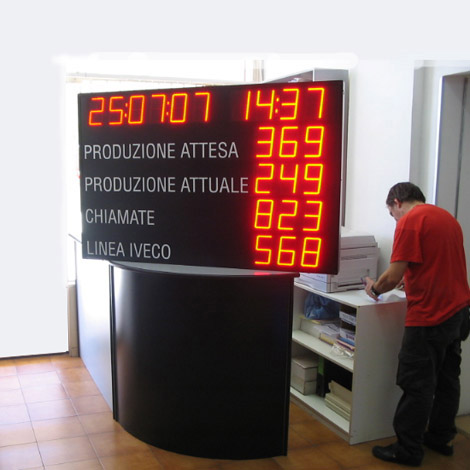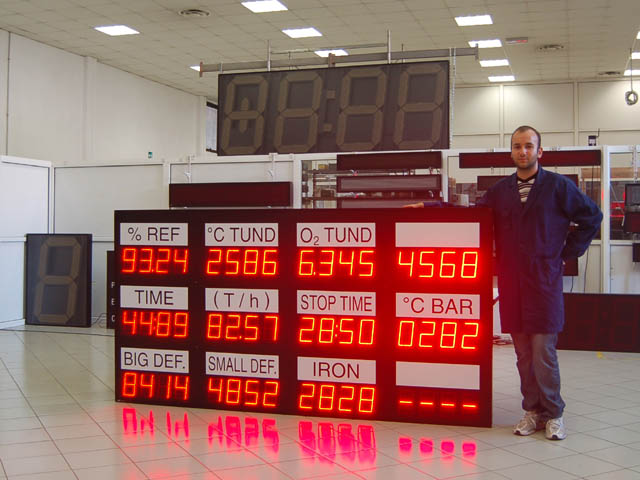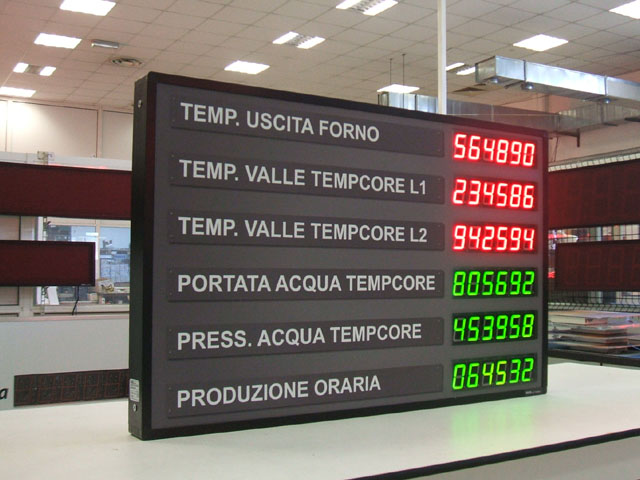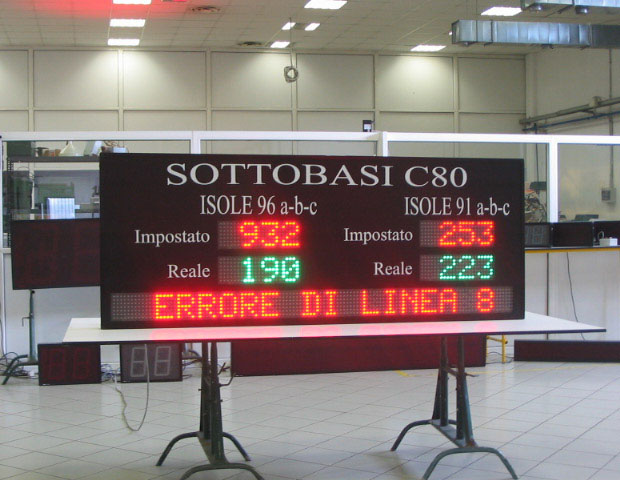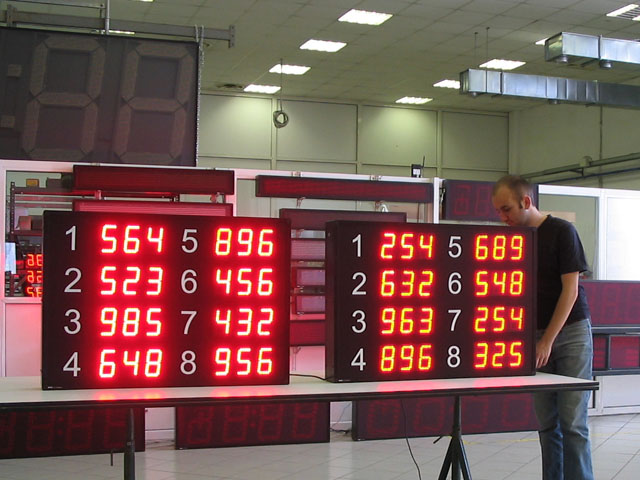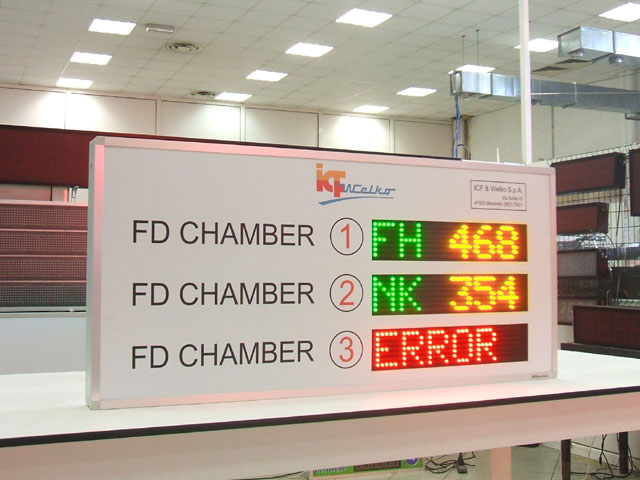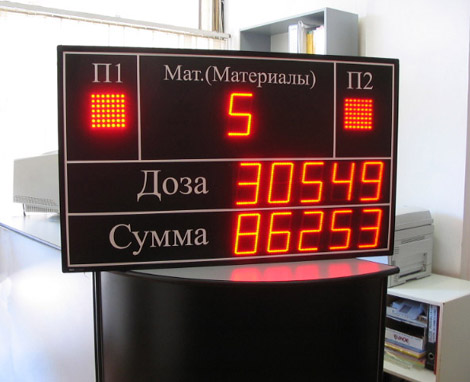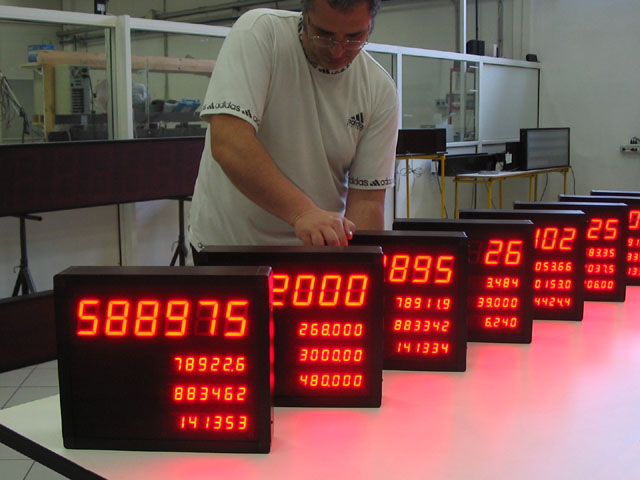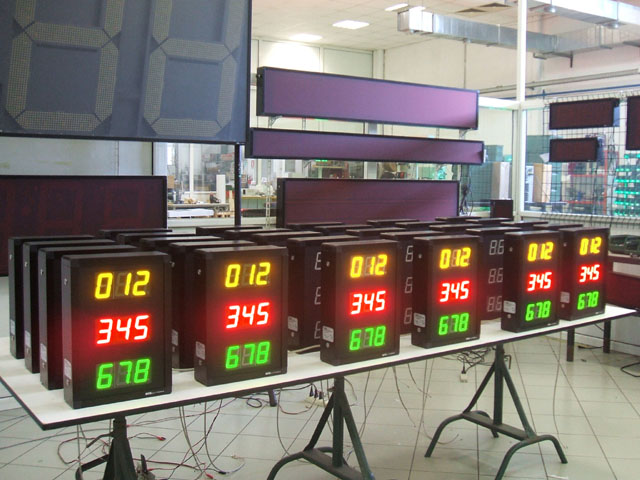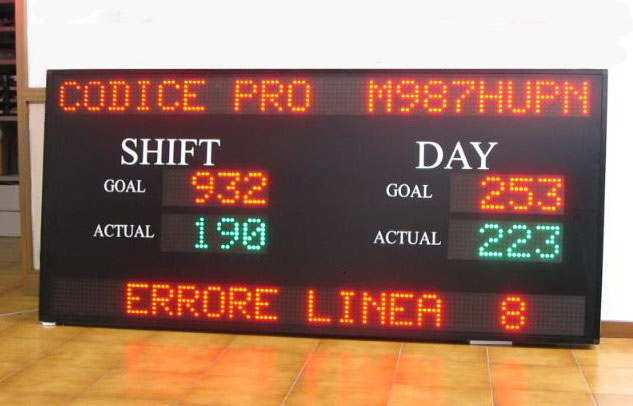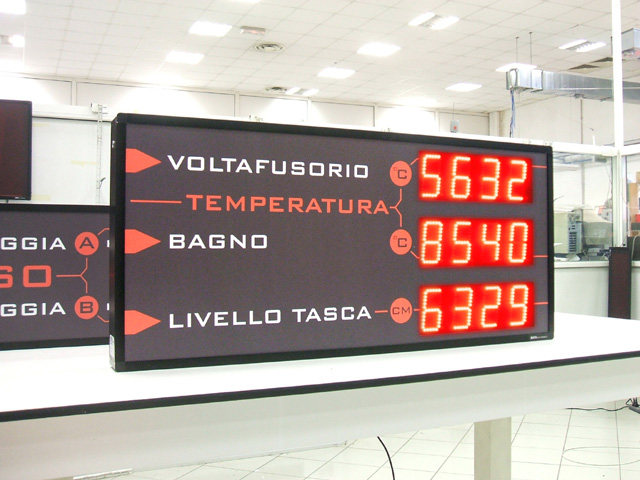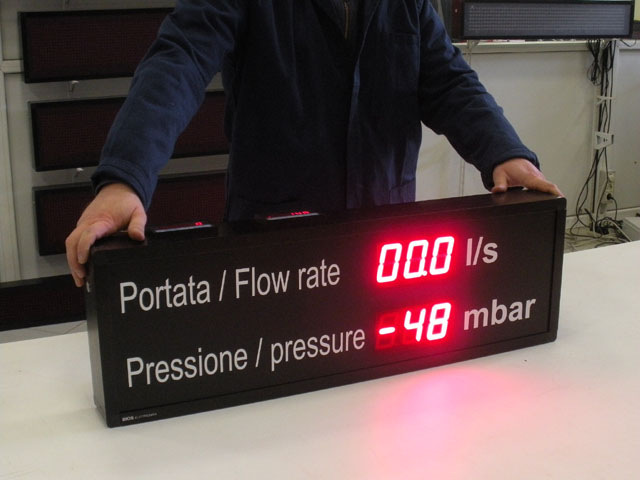This kind of large Display is used mainly in industrial areas when it is necessary to visualize information composed from separate fields of different typologies (letters, numbers, signals etc.), of different dimensions, fixed or variable, visible from long distances (from 5 up to 300 meters).
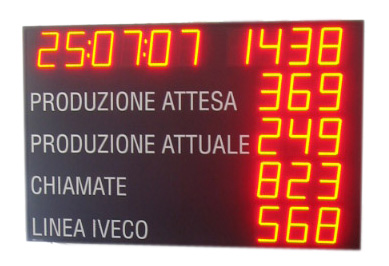
Display to monitoring takt time - produced quantities, Profinet interface
Every "Andon-X " is made on specific needs of the client assembling standard system modules available in various sizes. The modules can be numerical for numeric data and alphanumeric for letters and numbers. It is possible to integrate bright indicators that highlight a particular situation and fixed writings that give a better understanding of the visualized data. The fixed writings can be made with serigraphy or with adhesive vinyl film (generally of white colour).
Some example of displaying data:
- Target
- Takt time
- Allarms
- Errors on line
- Shift
- >Line efficiency
- Production and yield coefficients
- Produced pieces
- Speed of tapes
- Fixed and scrolling messages
- Time and date
- Days without accidents
- Produced-Consumed-Saved energy
Andon-X can be integrated in a process of production connecting its modules to industrial machines, computers or PLC by the following types of input: Profinet interface, Profibus, RS232/422/485 serial port; N/O dry contacts; parallel BCD or multiplexed BCD; in tension (0-10V, 0-5V, 1-5V); in current (4-20 MA, 0-20 MA).
All the models can be supplied with the chassis predisposed to be installed outdoors exposed to atmospheric agents (IP55). Moreover it is possible to have a greater level of protection for cases in which the display has to be installed in a more critical environment, for example in places where strong jets of water are used from the bottom upward (IP65) or in an industrial shed where there are very aggressive acid vapors.
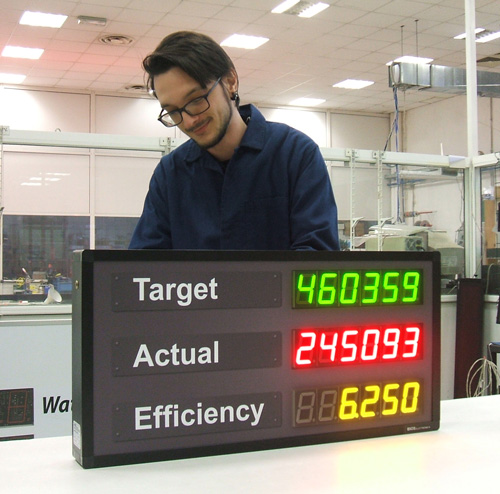
Display for Target - Produced pieces - Efficiency, Profibus interface
Regarding characteristics of single modules of which the "scoreboards" can be composed, you can look at the description of the series: Textronic (one row display), Multitext (multiple rows display) and Numeric Displays.
However we invite you to ask for additional technical details and an eventual offer selecting Contact us on the bottom. If you need a preventive, please specify the type (numeric or alphanumeric) and the quantity of the data that has to be visualized, the prefered way to update information (connection) and the distance from which the scoreboard has to be readable.
Andon-X is a tool for visual inspection.
It is essential where there is a need to keep informed in real time all the operatorsin a particular department about the status of a process and highlight any anomalies or emergencies.
The visibility at great distances, high brightness LEDs, the strong visual impact and solidity of the structure are the characteristics that differentiate it from a traditional monitor.
Some examples of displayable data:
- Production schedules
- Objectives to be achieved
- Alarms
- Line errors
- Coefficients of production and efficiency
- Number of pieces produced
- Messages fixed and sliding
- Current time and date
- Number of days without injuries
- Energy consumed-produced-spared
Andon-X can be interfaced to one or more PCs and PLCs on the network or directly to analog instruments and sensors with the following connection types:
- Profinet interface
- Profibus interface
- RS232
- RS422
- RS485
- Ethernet
- Wi-Fi
- BCD (Binary Coded Decimal)
- BCH (Binary Coded Hexadecimal)
- Parallel input 8-bit binary encoding
- Analog voltage 0-10V
- Analog current input 4-20mA
- Clean Contacts N/A
- Radiomodem
- Manual Radiocomando
- GSM by sending SMS
- GPRS via Internet
The Display can also be equipped with several different interfaces, one for each modules /fields of which is compound (numeric fields, alphanumeric, acoustic signals ...).
Andon-X has not, unlike other types of displays, default features. It is produced in a "custom", according to the ever changing customer needs by assembling several basic modules. The basic modules can be distinguished for
- numerical data
- alphanumeric codes
- fixed messages
- scrolling messages
- light signals
- acoustic signals
size, and then reading distance:
The modules are available with the following digit heights:
- Cm. 5,6 readable from about 15-20 meters;
- Cm. 15 readable from about 45-60 meters;
- Cm. 23 readable from about 69-92 meters;
- Cm. 32 readable from about 96-128 meters;
- Cm. 47 readable from about 141-188 meters.
The alphanumerical modules are available with the following digit heights:
- Cm. 3, readable from about 9-12 meters;
- Cm. 5, readable from about 15-20 meters;
- Cm. 8, readable from about 24-32 meters;
- Cm. 11, readable from about 33-44 meters;
- Cm. 16, readable from about 48-64 meters;
- Cm. 20, readable from about 60-80 meters.
The traffic signal modules are available with the following digit heights:
- Cm. 8x8, perceived from about 40 metri;
- Cm. 11x11; perceived from about 55 meters;
- Cm. 16x16; perceived from about 80 meters;
- Cm. 20x20. perceived from about 100 meters.
To focus on the configuration of the Display more suitable to your needs, you should ask yourself the following questions:
- How many variable fields should show Display?
- For each field to define whether to display only numbers or letters only, or both;
- For each field to define how many numbers / letters must be displayed;
- From how many meters the displayed data must be readable?
- How do you want to interface the Display? (RS232, RS485, Ethernet, BCD, 8 bit, 0-10V, 4-20mA, Contact N/A etc.);
- The fields can all be of the same color (ex. red) or you want different colors? (red, green, yellow, blue);
- Do you want fixed writings near the variable fields? (ex. pieces produced, objective etc.);
- Must be installed indoors or outdoors?
- Are present in the environment particular dust or corrosive acid fumes?
- What Power Supply do you need? (12V, 24V, 110V, 220V);
- There is a maximum size that the Display should not exceed?
- How do you want the fields to be visually organized?(comp image example may help).
Binary-coded decimal (BCD) encoding is a popular way in informatics and electronics to represent decimal number in Binary-code.
In this format every number's digit is represented by a binary code made up by four bits, where the value is between 0 (0000) and 9 (1001). The other six combinations can be used to represent symbols. For example number 127 is represented in BCD like this: 0001, 0010, 0111.
Because computers store data in bytes of eight bits, you can store a number for byte and fill the remaining four bits with zeros or one (as in the EBCDIC code), or put two digits per byte, packed BCD call mode. The packet BCD numbers normally end with a sign code, usually 1100 for + and 1101 for -. The number 127 is represented by 11110001, 11110010, 11110111 in EBCDIC and 00010010, 01111100 in packet BCD.
Although the BCD involves a considerable waste of bits (about 1/6 of unused memory in packed BCD), and in some cases it is preferable because it has a direct correspondence with the ASCII code. It is sufficient to replace the first four unused bits with 0011 to obtain the corresponding ASCII.
The BCD code is very popular in electronics, especially in digital circuits without microprocessor, because it facilitates the visualization of long digits of seven segment display, because each physical display corresponds exactly one digit. There are special integrated circuits that perform the conversion from BCD in the corresponding power-on sequence of segments. Even performing simple arithmetic is easier to be made of BCD digits for combinational logic circuits.
The BIOS of the personal computers store the date and time in BCD format, presumably for historical reasons.
Andon is a technical term used in industrial production. The word "Andon" is the japanese name of a paper lantern, but in factory language indicates a panel or a control panel. The Andon is an instrument of direct visual control on the production process, used to stop the line in case of anomaly. The traditional version of the Andon-Display contains a row of numbers that light up to indicate the status of work. If there are not problems, the light is green. When the worker needs the intervention of a responsible he presses a button to turn the yellow light. If you must block the line he presses the button for the red light. In the Japanese method of production, workers are encouraged to stop the line if necessary, because it is deemed necessary to meet the criteria of total quality to be achieved. So the Andon rose to represent a system of Total Quality Control.
The reading distance depends on the size of the characters that the display is capable of displaying. The reading distance does not depend on brightness. The following table shows the read range depending on size. By convention we refer only to character height.
Numerical modules (7 segments) | |
height in cm. | legibility distance in mt. |
5,6 | 15-20 |
10 | 30-40 |
15 | 45-60 |
23 | 69-92 |
32 | 96-128 |
47 | 141-188 |
100 | 300-400 |
Alphanumerical modules (7x5 dot matrix) | |
height in cm. | legibility distance in mt. |
3 | 9-12 |
5 | 15-20 |
8 | 24-32 |
11 | 33-44 |
16 | 48-64 |
| 20 | 60-80 |
